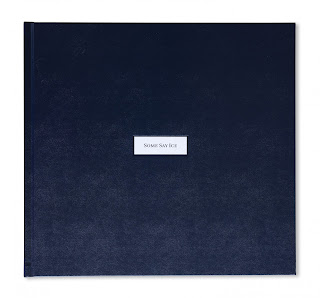In The Photobook: A History Vol. 2, Gerry Badger and Martin Parr describe the 1973 book by historian Michael Lesy, Wisconsin Death Trip, as being
"Ahead of its time, not because it was a published collection of nineteenth-century vernacular photographs....but because of Lesy’s attitude to his material. He looked upon the photographs of Charles Van Schaick, taken between 1890 and 1910 in the town of Black River Falls, Wisconsin, in a way that predicted postmodernism. To say that he viewed them skeptically would be overstating the case, but he certainly did not take them at face value, and he treated them proactively rather than reactively – that is, as a creative resource."
The book is now an essential part of photobook history, revered as a sort of cult classic. Wisconsin Death Trip is a romantic story that Badger and Parr go on to compare to Steichen’s The Family of Man, I’m So Happy by Heiferman and Kismaric, and Portraits and Dreams by Wendy Ewald. These books were all developed by their authors working with collections or archives of photographs, rather than a more typical photobook with the author in charge of a camera, though Wisconsin Death Trip is unique in the sort of ownership the curator assumed in defining the meaning of the pictures.
 |
If you are unfamiliar with the book, it started as a master’s degree project of Lesy’s while a student of American History at the University of Wisconsin. Perusing the archives of the Wisconsin Historical Society, Lesy stumbled upon some glass plate negatives made by Charles Van Schaick, a collection of 8,000 photographs made in Black River Falls, Wisconsin between 1895-1940. Lesy went on to pursue a PhD in American History at Rutgers University, and two hundred of these pictures were again included in his doctoral thesis. Wisconsin Death Trip grew out of his graduate work, and again developed using Van Schaick’s pictures, this time distilling the collection down to 130 pictures. To complete the book, Lesy paired the photographs with different historical documents pulled from newspapers and other sources. These documents describe various crimes, misdemeanors and tragedies in Black River Falls and its neighboring communities, and combined with Van Schaick’s photographs, Lesy created a historical narrative of a region in deep despair and with a film noir-like feel. I like to think of Wisconsin Death Trip as being similar to In Cold Blood by Truman Capote, who described his book as a nonfiction novel. Looking at it this way, we can better understand the assertion that Wisconsin Death Trip predicted postmodernism.
 |
 |
Over 40 years later, Magnum photographer Alessandra Sanguinetti returned to Black River Falls to photograph the region the way she saw it, referring to Wisconsin Death Trip as a primary influence when she was first embracing photography as a young woman in Bueno Aries. Sanguinetti returned decades later armed with a much more sophisticated vision than Lesy or Van Schaick, but like its predecessor, Some Say Ice is an instant classic. Unlike Lesy, Sanguinetti made her own photographs, and they reveal a tremendous visual sophistication. The design and production of Some Say Ice are traditional, simple and rich. All in black-and-white, each spread is just one picture, and guides us through a meditation on Middle America. Going through the book can feel intoxicating, as page after page you see pictures that so beautifully mix photographic technique with a curious approach to psychology, equally as enigmatic as it is flawless. Washington Post critic Kenneth Dickerman compares Some Say Ice to an A24 film, an apt comparison that I think describes a similar reading to the pictures — somehow confoundingly bleak and beautiful, harsh and compassionate.
Like Wisconsin Death Trip, Sanguinetti’s book is a dark romance about Middle American disillusionment and despair. She isn’t as grounded in the photographic vernacular as Lesy, though the book does reference vernacular photographic traditions (I love the group portraits of the young girls — the Black River Fall Varsity Girls Basketball Team and the Catholic School). Instead, she brings incredible visual skills, full of a masterful understanding of lighting, tonality and sequencing, to create a narrative that is quintessentially American, and yet somehow made new and inventive again. Like any good photobook about America, this one is puzzled together with the same tropes, metaphors and symbols — God, guns, new frontiers, deeply held secrets and a curiously humble beauty.
 |
 |
Despite these praises for Some Say Ice, I will confess to being a little disappointed by this book. If you are familiar with the wonderful early books by Sanguinetti, On the Sixth Day and The Adventures of Guille and Belinda and The Enigmatic Meaning of Their Dreams, these are much richer with humility, affection, and deeper connection with a place, and as a result they represent much greater feelings of compassion and affirmation. Some Say Ice feels cooler and more aloof, as though developed with a much more conceptual framework (perhaps something like Lesy), ultimately embracing a clinical and distant perspective. Her early books have a wonderful naivety — the discovery we witness in the girls photographed in The Adventures of Guille and Belinda parallel the photographer’s discoveries — and Some Say Ice is anything but naïve. Nevertheless, the book is tightly edited, with each photograph demonstrating a superlative visual and technical aptitude.
Purchase Book
Read More Book Reviews
 |
 |
 |
Brian Arnold is a photographer, writer, and translator based in Ithaca, NY. He has taught and exhibited his work around the world and published books with Oxford University Press, Cornell University, and Afterhours Books. Brian is a two-time MacDowell Fellow and in 2014 received a grant from the Henry Luce Foundation/American Institute for Indonesian Studies.










